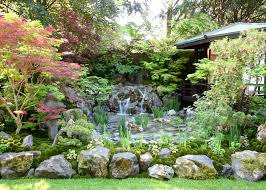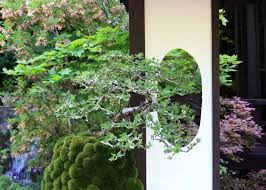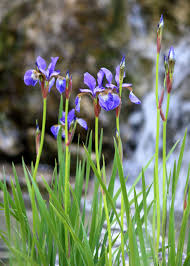 Three cheers for Kazuyuki Ishihara: another Chelsea gold medal to his name and ‘Best in Show’ for his Artisan Garden entitled O-mo-te-na-shi no NIWA. Although the charismatic Japanese landscape artist is now as much a part of the Chelsea Flower Show as Pimms, the Queen or improbably large delphiniums, we know relatively little about him. Mr. Ishihara speaks limited English and comes across as shy, except when he learns of the judge’s final decision. Such is his passion for his craft, and for Chelsea, that he goes wild with excitement, and quite right too. He has a track record that very few designers can match. He has now been awarded a gold medal for seven years consecutively and best Artisan Garden on five of those occasions. Mr. Ishihara was the first Japanese designer ever to win the President’s Award at Chelsea, back in 2016 for his Senri-Sentei – Garage Garden. I did a very poor job of photographing that garden so didn’t feature it at the time, but have included an image at the end of this post so that you may compare this more contemporary design with this year’s traditional garden. With the assistance of Google, I have taken the opportunity to include a Japanese translation of these words. Apologies for any errors, but I hope you get the gist!
Three cheers for Kazuyuki Ishihara: another Chelsea gold medal to his name and ‘Best in Show’ for his Artisan Garden entitled O-mo-te-na-shi no NIWA. Although the charismatic Japanese landscape artist is now as much a part of the Chelsea Flower Show as Pimms, the Queen or improbably large delphiniums, we know relatively little about him. Mr. Ishihara speaks limited English and comes across as shy, except when he learns of the judge’s final decision. Such is his passion for his craft, and for Chelsea, that he goes wild with excitement, and quite right too. He has a track record that very few designers can match. He has now been awarded a gold medal for seven years consecutively and best Artisan Garden on five of those occasions. Mr. Ishihara was the first Japanese designer ever to win the President’s Award at Chelsea, back in 2016 for his Senri-Sentei – Garage Garden. I did a very poor job of photographing that garden so didn’t feature it at the time, but have included an image at the end of this post so that you may compare this more contemporary design with this year’s traditional garden. With the assistance of Google, I have taken the opportunity to include a Japanese translation of these words. Apologies for any errors, but I hope you get the gist!
石原一之の3つの喝采:彼の名を冠したチェルシーの金メダルとアルティザン・ガーデンの「ベスト・イン・ショー」、O-mo-te-na-shi no NIWA。カリスマ的な日本の芸術家は、今やチェルシー・フラワー・ショーの一部として、ピムス、クイーンズ、おそらくは大型のデルフィニウムのようなものですが、彼についてはほとんど知りません。石原氏は、限られた英語を話し、裁判官の最終判決を知る以外は、恥ずかしがりのように見える。そのような彼の工芸品への彼の情熱、そしてチェルシーのために、彼は興奮して野生になり、かなり正しい。彼は、ほとんどのデザイナーが一致することができる実績を持っています。彼は現在7年間連続して金メダルを獲得しており、そのうち5つで最高のArtisan Gardenが授与されています。石原氏はチェルシーで大統領賞を受賞した最初の日本人デザイナーで、2016年にはセンリ・センテイ・ガレージ・ガーデンのために誕生しました。私はその庭を撮影するのは非常に貧弱な仕事をしていましたが、当時の特徴はありませんでしたが、今年の伝統的な庭とこのより現代的なデザインを比較できるようにこのポストの終わりにいくつかの画像が含まれています。 Googleの助けを借りて、これらの言葉の日本語翻訳を含める機会を得ました。何か間違いをお詫びしますが、要点を得ることを願っています!
 It has been said by myself and others that Kazuyuki Ishihara is a one-trick pony. Looking back to 2004 when he first staged a Chelsea garden, one learns that this is far from the truth. His style has evolved considerably over the last 14 years, making me even more excited to see what he chooses to do next. Even if he chose not to move on, what a thrill it always is to see this style of the garden made so impeccably. I could gaze at his show gardens all day long and never tire of them. I was delighted that he took a moment to have his photograph taken with me, something I rarely ask anyone I don’t know to do. To find out more about the man, have a look at the short film below. Persevere with it, as his story is a good one.
It has been said by myself and others that Kazuyuki Ishihara is a one-trick pony. Looking back to 2004 when he first staged a Chelsea garden, one learns that this is far from the truth. His style has evolved considerably over the last 14 years, making me even more excited to see what he chooses to do next. Even if he chose not to move on, what a thrill it always is to see this style of the garden made so impeccably. I could gaze at his show gardens all day long and never tire of them. I was delighted that he took a moment to have his photograph taken with me, something I rarely ask anyone I don’t know to do. To find out more about the man, have a look at the short film below. Persevere with it, as his story is a good one.
石原一之はトリックポニーの一人だと言われています。 2004年にChelseaの庭を初めて上演したとき、彼はこれが真実から遠いことを学びました。 彼のスタイルは過去14年間でかなり進化しており、私は彼が次に何をするかを見てさらに興奮しています。 彼が移動しないことを選択したとしても、いつもこのスタイルの庭園を見ることが、どんなにスリルであっても、まったく完璧になりました。 私は一日中、彼のショーガーデンを注視することができ、決して疲れない。 私は自分の写真を私と一緒に撮ってもらうために瞬間を取ったことを嬉しく思っています。 その男についてもっと知るには、下のショートフィルムを見てください。 彼の物語は良いものなので、それを忍耐してください。
To Western eyes at least, this year’s garden, inspired by the treasured Japanese culture of omotenashi, appears to be the embodiment of Japanese garden design. It has water, rocks, acers, irises, moss, bonsai, lanterns and an octagonal pavilion, all the ingredients we expect to see in such a garden. Omotenashi, is the concept of wholehearted and sincere hospitality, and they wish to invoke this feeling in guests to the garden. The planting is based on Ikenobo, a style of Japanese flower arranging dating from the 15th century. This is where Mr. Ishihara began, studying this, the purest form of Ikebana, from the age of 22. The placement of plants and the distribution of color in this garden are carefully considered in relation to space.
西洋の目には少なくとも、オオテナシの貴重な日本の文化に触発された今年の庭は、日本の庭のデザインの一形態と思われる。 それは、水、岩、エイサー、虹彩、苔、盆栽、灯篭、八角形のパビリオンを持っています。 心のこもったホスピタリティのコンセプトであり、お客様の庭にこの気持ちを呼び起こしたいという思いがあります。 植栽は、15世紀の日本の花の様式である池坊をベースにしています。 これは、石原氏が始まった場所で、22歳から純粋な形の生け花を研究しています。この庭の植物の配置と色の分布は、空間との関係で慎重に検討されます。
Mr Ishihara’s latest composition is enhanced by a fabulous, shaded location in a woodland glade between Eastern Avenue and the other Artisan Gardens. The backdrop of birch, beech, and Atlantic blue cedar is perfect, creating a seamless transition between temporary garden and permanent surroundings. It is almost impossible to find fault with his gardens, which are executed and maintained throughout the show to such a high standard. Dust and debris are removed from the water and pincushion moss daily, by hand.
石原氏の最新作は、イースタン・アベニューと他のアルティザン・ガーデンの間の森林の隙間にあるすばらしい、影のある場所によって強化されています。 バーチ、ブナ、大西洋の青白い杉の背景は、一時的な庭園と恒久的な環境の間でシームレスな移行を作り、完璧です。 彼の庭園で不具合を見つけることはほとんど不可能であり、その庭園はショーの間に実行され維持されています。 毎日水とピンカスの苔からほこりや土石を手で取り除きます。
 The focal point in this year’s garden is an octagonal Azumaya, or garden house, with a gently sloping roof fashioned from copper. A central pool of grey stone, studded by irises, is fed by three crystal-clear cascades. The pool is surrounded by Japanese maples interspersed with pines, viburnums and a handsome enkianthus. The natural sound of water falling onto rock is intended to encourage the forgetting of time and the feeling of eternity. Every detail of the garden is considered, including the front boundary of pincushion moss, Pachysandra terminalis, and Houttuynia cordata ‘Chameleon’. Flanking the entrance to the Azumaya, the two twisted larches are actually bonsai that have been trained with wires to look especially ancient. Like everything else in the garden, they are quite marvelous.
The focal point in this year’s garden is an octagonal Azumaya, or garden house, with a gently sloping roof fashioned from copper. A central pool of grey stone, studded by irises, is fed by three crystal-clear cascades. The pool is surrounded by Japanese maples interspersed with pines, viburnums and a handsome enkianthus. The natural sound of water falling onto rock is intended to encourage the forgetting of time and the feeling of eternity. Every detail of the garden is considered, including the front boundary of pincushion moss, Pachysandra terminalis, and Houttuynia cordata ‘Chameleon’. Flanking the entrance to the Azumaya, the two twisted larches are actually bonsai that have been trained with wires to look especially ancient. Like everything else in the garden, they are quite marvelous.
今年の庭園の焦点は、八角形のAzumaya(ガーデンハウス)で、銅製のやさしい屋根があります。 虹彩に囲まれた灰色の石の中央プールは、3つのクリスタルクリアカスケードによって供給されます。 プールには、松、芝生、ハンサムなエンカンサスが散在している日本の庭園に囲まれています。 岩の上に落ちる自然な音は、時間と永遠の感覚を忘れることを奨励することを意図しています。 ピンカス苔、Pachysandra terminalisおよびHouttuynia cordata ‘Chameleon’の前境界を含めて、庭のすべての詳細が考慮されます。 Azumayaへの入り口に面した2本の撚り糸は実際には昔から見えるワイヤーで訓練された盆栽です。 庭の他のすべてと同様に、彼らは非常に素晴らしいです。
Mr. Ishihara calls himself a landscape artist because that is what he is. He creates a picture of natural perfection by deftly balancing all the elements. We suggest that he does the same thing every year because we can’t find fault elsewhere, and because our memories are short. That is our failure and not his. We are extremely fortunate to have him come to Chelsea every year to remind us of the beauty, precision, and meaning of Japanese gardens. And what would Chelsea be without his priceless reactions to good news? Definitely not the same. TFG.
石原氏は、それが彼のものなので、庭師と呼んでいます。 彼はすべての要素を巧みにバランスさせることによって、自然の完璧な姿を描きます。 私たちは毎年同じことをすることをお勧めします。なぜなら、私たちはどこかで不具合を見つけることができず、私たちの記憶が不足しているからです。 それは私たちの失敗であり、彼の失敗ではありません。 日本の庭園の美しさ、精密さ、そして意味を思い起こさせるため、彼は毎年チェルシーに来られることは非常に幸運です。 そして、チェルシーは、良い知らせをすることなく、何ができるでしょうか? 確かに同じではありません。 TFG。